A Historic Look at Harness Racing's Little Brown Jug in Delaware Ohio
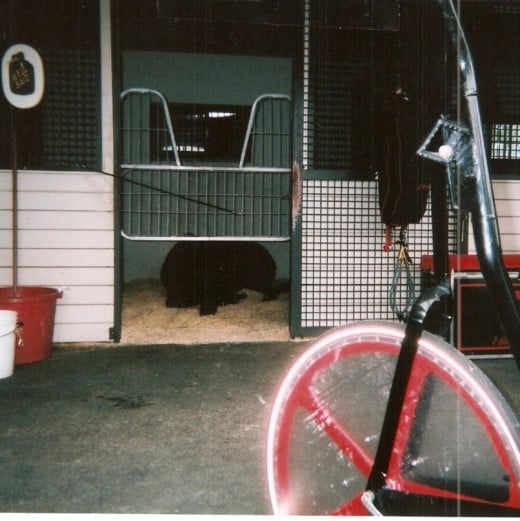
It was a dream trip for Well Said in his second heat in winning harness racing's Little Brown Jug September 24, 2009. He had already dominated in his elimination heat.
Apparently, the 2009 North America Cup winner and leading pacer in North America was having sweet dreams of victory a few hours before pacing smartly through his Jug elim, as demonstrated in pre-race photos taken of him (right).
The movie Seabiscuit demonstrated what a relaxed horse is, but Well Said took Seabiscuit's napping habits to another level before the Jug. The land's leading money winning pacer (2009) was curled up on the wood chips in his stall, his head propped on his legs like a big ol' puppy-dog as he casually eyed flash-bulb-popping visitors vying for viewing space in stall row.
Spectators oohed and aahed at him as they speculated how such a relaxed demeanor was a great pre-race sign -- because Well Said always napped this way before his best racing efforts. Well Said's fans were right. The big bay Western Hanover colt was the 5-2 favorite for his elim heat ahead of second choice Carnivore (4-1) before cruising to the Jug heat wire over Vintage Master. Then he flew three-wide at the turn to wear down half-brother If I Can Dream in the final, with Vintage Master finishing 5th.
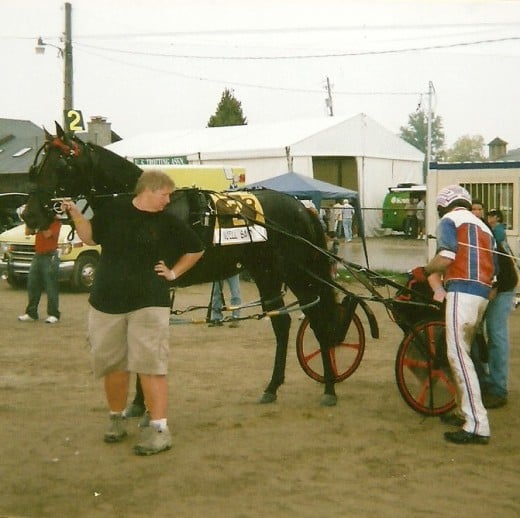
Those Hanover Boys
As well as being progenitor to the two sons that fought it out for the 2009 Jug title, Western Hanover had three sons who sired or grandsired Jug entries that year.
Western Hanover son The Panderosa grandsired Jug participant Carnivore. Western Terror sired Straight Shooting, who finished 3rd in the final Jug heat, and Western Ideal fathered Vintage Master, who also won the 2009 Cane Pace.
Doubleshotascotch, a Western Hanover grandson, paced in 2009's first Jug elimination heat.
Hanover Shoe Farms in Pennsylvania has been a breeding hotbed for Standardbred harness racers since before the first running of the Little Brown Jug in 1946. Many breeders/owners choose to make their stables' name part of the names of their new foals. It is one way to easily accommodate the many horse racing rules and requirements that govern naming horses.
Harness Racing's Pacing Triple Crown
Unlike Thoroughbred racers, Standardbred harness racers pull a two-wheeled cart (sulky or bike) with a driver and pace or trot a one mile race. A racing event may be made up of one to three elimination heats (each one mile) and a final mile to determine an overall winner.
The Little Brown Jug is held annually in Delaware, Ohio, in September during the week of the Delaware County Fair at the fairgrounds. It features the cream of the crop of three-year-old pacers and is, overall, Standardbred racing's most famous pacing event.
The most well known and historic race for trotters is the Hambletonian, named after one of the Standardbred breed's foundation sires. Messenger, who sired Hambletonian(s) -- the name was reused many times -- was a Thoroughbred who also trotted. Hambletonian(s) set the trotting records of the day in the 1800s.
In the history of harness racing, just 10 Standardbreds have achieved sweeping the Pacing Triple Crown. The Jug is the showcase race in this series of three pacing contests. The other races are the Cane Pace, which is held at the Freehold Raceway in Freehold, New Jersey, and the Messenger Stakes, part of the harness racing card at Yonkers Raceway in Yonkers, New York.
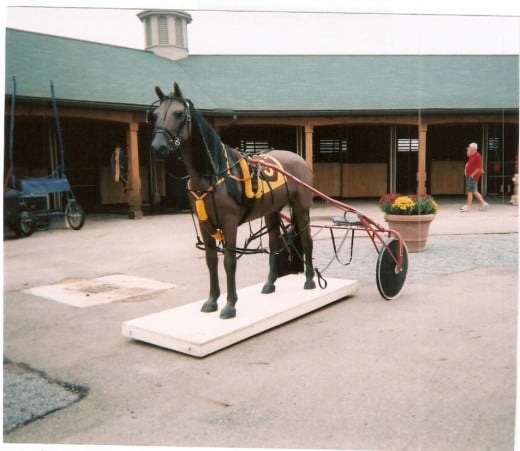
Pacing's Triple Crown was inaugurated in 1956 and first won in 1959 by Adios Butler. The other nine champions include:
- Bret Hanover, 1965
- Romeo Hanover, 1966
- Rum Customer, 1968
- Most Happy Fella, 1970
- Niatross, 1980
- Ralph Hanover, 1983
- Western Dreamer, 1997
- Blissful Hall, 1999
- No Pan Intended, 2003
No Pan Intended was trained by Deshler, Ohio's Ivan Sugg for Peter Pan Stables in Pepper Pike, Ohio.
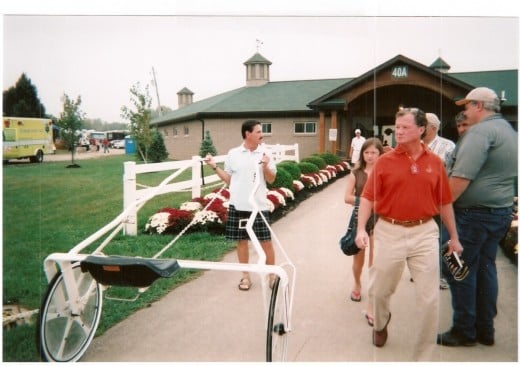
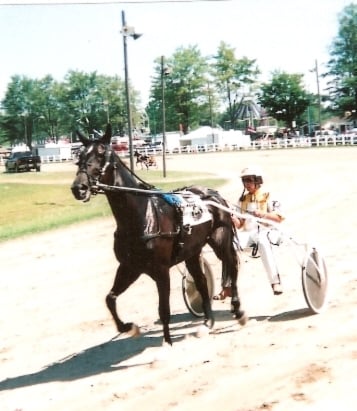
Little Brown Jug Beginnings
Like all Standardbred harness racing events, the Little Brown Jug is held at a county fairgrounds, a logical location for area horsemen. Modern racing features female racers as well as male contestants. The Little Brown Jug's female counterpart event is the Jugette, first held in 1971.
On site at the Little Brown Jug in 2008 was author Charlie Leerhsen, a former employee of the harness racing magazine Hoof Beats, and a Dan Patch historian. Pacer Dan Patch was the world's best pacer for his entire career, losing just one heat, and many times racing against Time (his clocked time for a mile) because horsemen paled with the challenge of entering their best pacers to compete against him.
Leerhsen authored the book, Crazy Good: The True Story of Dan Patch, The Most Famous Horse in America.
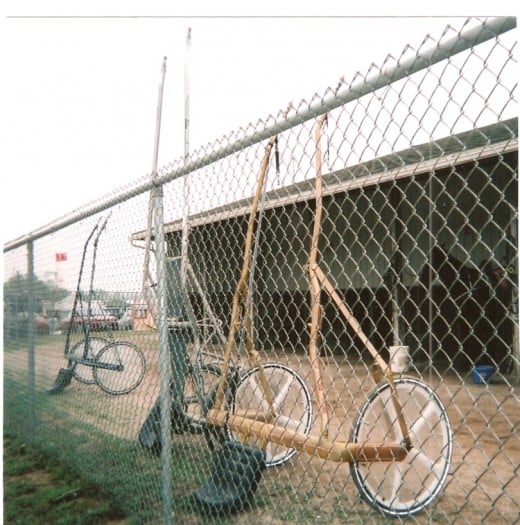
Trotting and Pacing Together
Trotting and pacing events both are held at any Standardbred day of competition. Pacers move laterally, while trotters move opposite front and hind legs at the same time. Trotters were harness racing's first stars, while pacers greatly picked up the pace in popularity when Dan Patch began to regularly break the two-minute mile in the early 1900s.
The Jug's first organizational meetings were held in 1937. Out of the friendship of Joe Neville, an attorney associated with the sport of Standardbred racing, and Henry C. "Hank" Thomson, editor of the Delaware County Gazette, blossomed a passion to bring pacers into equal status with trotters. That year the Delaware County Agricultural Society moved the county fair from Powell to Delaware.
A half mile track was built at the new location and used in 1944 and 1945 to showcase pacers, while a newspaper contest presented the event with its official name, the Little Brown Jug.
Wayne "Curly" Smart, a Delaware native, drove the first Jug winner, Ensign Hanover, to the winner's circle for a $35,358 payday. In 1951, Tar Heel became the Jug's first sub-two minute miler. His driver was Del Cameron.
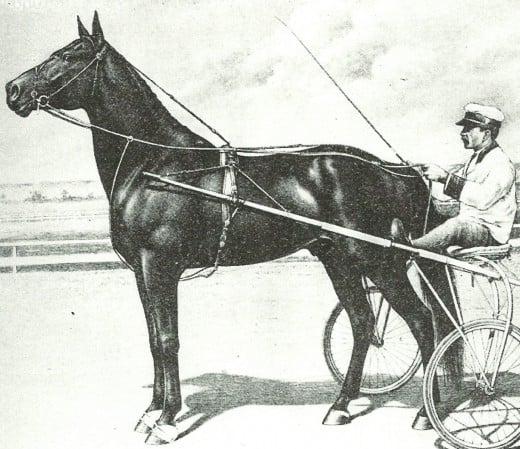
- Triple Crown of Harness Racing for Pacers - Wikipedia, the free encyclopedia
Standardbred Pacing's Triple Crown Winners
- What's In A Horse's Name?
What do horses' names mean and how are they chosen?
- Little Brown Jug (horse racing) - Wikipedia, the free encyclopedia
The founding of the Little Brown Jug, and its first race in 1946 is discussed.








